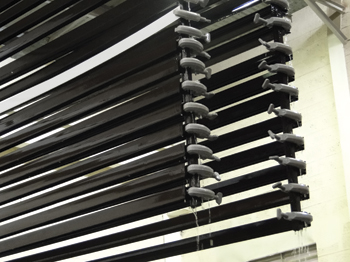Anodising line gives Balexco the edge
01 June 2014
Bahrain Aluminium Extrusion Company (Balexco) says its state-of-the-art anodising line from Monti Engineering of Italy, which was launched last year, has given it an edge in the market in terms of quality products that are aesthetic and corrosion resistant.
“The new facility is an automatic anodising, electro-colouring and dye colouring plant, with a capacity is 60,000 amps,” says Jassim Seyadi, CEO of the Bahrain-based aluminium extruder. “It is supported by a fully automatic effluent purification plant with a treatment capacity of 30 cu m per hour.”
The line is equipped with four anodising tanks that allows computerised thickness presetting; two electro-colouring tanks with computerised colour presetting and one for organic colouring.
The plant can carry out chemical etching and has an optimised automated handling system with automatic systems for dosing (full line) and temperature control.
Balexco offers a number of colours for its anodised aluminium including plain matt, while other special colours may be produced to customer specifications. The company follows a rigorous quality control and assurance programme, ensuring that the anodised products supplied meet the customers’ requirements on product integrity and colour uniformity.
Elaborating on the anodising process for aluminium and its application at Balexco, Seyadi says: “Anodising is an electrochemical process that transforms the metal surface with a decorative, durable, corrosion-resistant, anodic oxide finish. Aluminium is ideally suited to anodising, although other nonferrous metals, such as magnesium and titanium, also can be anodised.
“The anodic oxide structure originates from the aluminium substrate and is composed entirely of aluminium oxide, which is not applied to the surface like paint or plating, but is fully integrated with the underlying aluminium substrate, so it cannot chip or peel. It has a highly ordered, porous structure that allows for secondary processes such as colouring and sealing.”
 |
|
|
He adds that anodising is accomplished by immersing the aluminium into an acid electrolyte bath and passing an electric current through the medium.
“Anodising is, therefore, a matter of highly controlled oxidation – the enhancement of a naturally occurring phenomenon,” he emphasises.
Anodised aluminium is used in a diverse range of applications – from skyscrapers to satellites – to offer protection from the harsh environment.
“It provides attractive, low-maintenance, highly durable exteriors, roofs, curtain-walls, ceilings, floors, escalators, lobbies and staircases in towers and commercial buildings throughout the world,” he says. “Anodised aluminium has revolutionised the construction of computer hardware, exhibit displays for trade shows, scientific instruments, and a constantly expanding array of home appliances, consumer products, and building materials. Moreover, it is considered environmentally safe, producing few, if any, harmful effects to the land, air, or water.”
Some of the benefits of anodising that Seyadi cites include:
• Durability: Most anodised products have an extremely long life span and offer significant economic advantages through maintenance and operating savings. Anodising is a reacted finish that is integrated with the underlying aluminium for total bonding and unmatched adhesion;
• Colour stability: Exterior anodic coatings provide good stability to ultraviolet rays, do not chip or peel, and are easily repeatable;
• Ease of maintenance: Scars and wear from fabrication, handling, installation, frequent surface dirt cleaning and usage are virtually non-existent. Rinsing or mild soap and water cleaning will usually restore an anodised surface to its original appearance. Mild abrasive cleaners can be used for more difficult deposits;
• Aesthetics: Anodising offers a large increasing number of gloss and colour alternatives and minimises or eliminates colour variations. Unlike other finishes, anodising allows the aluminium to maintain its metallic appearance;
• Cost: A lower initial finishing cost combines with lower maintenance costs for greater long-term value;
• Health and safety: Anodising is a safe process that is not harmful to human health. Since the anodising process is a reinforcement of a naturally occurring oxidising process, it is non-hazardous and produces no harmful or dangerous by-products. “An anodised finish is chemically stable, will not decompose; is non-toxic; and is heat-resistant to the melting point of aluminium (630 deg C),” he concludes.
Established in 1977 as the first aluminium extrusion plant in the Gulf region, Balexco has taken the lead in the region in the production of high quality extrusions and systems, used mainly as aluminium doors, window frames and other products that are required in the construction industry.
The company is approved to the Qualanod standard for anodising of aluminium. It also provides full technical support and advice to all its customers and fabricators to ensure that the appropriate products are utilised for their applications.
- Cortec admixture inhibits corrosion
- SPPI advanced technology protects steel
- Aqua Cutter ideal for corroded concrete
- Anodising line gives Balexco the edge
- Hempel’s Versiline range extended



